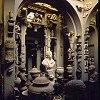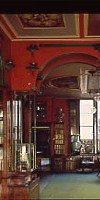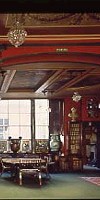 |
The house of Sir John Soane (1753-1837), one of
England's greatest architects, is a magical showcase of architectural
brilliance, invaluable collections and an eccentric mind.
In 1833, by means of an Act of Parliament, Sir John
Soane preserved the Museum which occupied No. 13 and the rear area
of No. 14, stipulating that it be left "as nearly as possible
in the state in which I shall leave it". The rooms now appear
almost exactly as they did on the day of Soane's death.
The house was a brilliant PR opportunity for Soane;
you could almost describe it as his elaborate portfolio. Trying
to 'sell' himself, he took clients around to show them what he could
do. This was pure genius, just like his inventions: it is impossible
not to be moved by the sheer drama and mystery of the house. Peek
through a window or in a mirror and you discover rooms within rooms,
hidden stairways, statues emerging from the shadows, or invisible
sources of light - it's simply magical.
When I visited the museum, I was guided around by
Will Palin. "Soane loved the drama of architecture," Will
explained as we entered the combined dining room and library (not
having a dividing wall was almost unheard of during Soane's lifetime).
This room, as all of the house, is about expanding the apparent
space. The design is so that you're not sure where the room ends:
"Soane pushed the boundaries of structures, using mirrors,
glass and light to create the desired effect. For example, he used
yellow glass in his windows to enrich the light and give the impression
of a sunset in Rome," says Will.
The Study is a remarkable room, housing a splendid
collection of antique marble fragments arranged as to draw the eye
to the beauty of their form and the variety of carved ornament (see
picture on previous page). "Soane didn't start collecting until
he was around 40," says Will. "In 1790, he had the financial
means to do so as he inherited a large property portfolio from his
wife's uncle. He bought everything in London auctions and spent
days arranging the fragments."
The scope of the eclectic collection is almost overwhelming,
taking in china, busts, oil paintings, stained glass, architectural
models, coins, death masks, skeletons, clocks, and alabaster frescoes.
The Picture Room is perhaps the most stunning room
of all. The most famous works are the two series of pictures by
William Hogarth (1697-1764). There are also works by, for example,
Henry Fuseli and Sir James Thornhill. The Picture Room contains
a total of more than one hundred pictures as the walls are, in fact,
hinged screens that double the space of the room. Behind the screens
are a watercolour, 'Kirkstall Abbey' by J M W Turner and fifteen
drawings by Piranesi. But, as with all of Sir John Soane's Museum,
the surprise doesn't end there. The screens open again, as if they
are stage curtains, to reveal a statue of a nymph by Sir Richard
Westmacott, dramatically lit by strong yellow light from above.
If you dare, you must visit the basement Crypt.
It was intended to have an atmosphere reminiscent of Roman burial
chambers or catacombs. The Sepulchral Chamber contains the sarcophagus
of Pharao Seti I, one of the most important Egyptian antiquities
ever to be discovered. The sarcophagus was purchased by Soane in
1824 after the British Museum refused the price of £2,000.
"Soane celebrated the arrival with a three day party. He invited
nearly a thousand guests and used more than three hundred oil lamps
to illuminate the house. Even the burial casket was lit from within.
The effect must have been breathtaking," says Will.
After visiting the peculiar The Monk's Parlour,
a mock-gothic room which Soane pretended was the home of 'Padre
Giovanni', you're stuck with the impression that Soane was, to say
the least, very eccentric. How was he regarded during his lifetime?
"He was much criticised, and the 'Soane style' was not revived
until the 20th century," says Will. "But the Museum itself
was always appreciated, and Soane was respected by other architects,
a profession he regarded as the 'Queen of the arts' above sculpture
and painting."
"This house was his little universe. After
his wife's death in 1815, he kept adding things, knocking down walls,
constantly rearranging objects... His sons didn't become architects
and so he failed in his plan to start an architect dynasty. But
he was a bricklayer's son and didn't want to go back to anonymity,
so he decided to establish the house as a museum to which 'amateurs
and students' would have access," explains Will. "This
house became his legacy."
Sir John Soane's Museum
13 Lincoln's Inn Fields
London WC2
tel: 020 7430 0175
admission: free
open: Tuesday to Saturday inclusive, 10am - 5pm. Also on the first
Tuesday of each month, 6 - 9pm. Closed Sunday, Monday, Bank Holidays
and Christmas Eve.
Tired of the current election? Don't miss the Hogarth's
Election Entertainment in association with Private Eye magazine
in the Soane Gallery. The Hogarth series Election, a political
satire with wonderful details, is considered to be among his very
best work and the caricatures (many from Private Eye magazine) are
equally sharp. This exhibition, open until August 25, is a joy.
By Lisa Bjurwald
Photographs © Martin Charles
|


